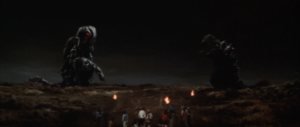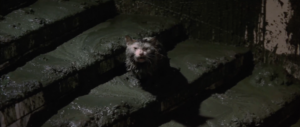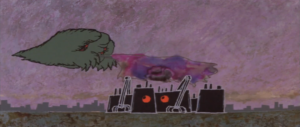24th July 2021 marks the fiftieth anniversary of Godzilla vs. Hedorah, the eleventh film in Toho’s famous franchise. For years, it was reviled by fans and critics alike, before receiving a critical reappraisal over the last decade or so. Whether or not one likes the film, it’s difficult to argue that it isn’t a significant entry in the series. Tonally and visually, it is distinct, comparable to the 1954 Godzilla in how forceful it is with its thematic content.
Fifty years on, what is it that makes Godzilla vs. Hedorah more relevant than ever? And what is it that makes it so deserving of the critical praise it now receives? Join me as we celebrate and explore Yoshimitsu Banno’s unique take on Godzilla.
GODZILLA FOR A NEW GENERATION
Godzilla “for a new generation” was the instruction laid out by long-time Godzilla producer Tomoyuki Tanaka to then-forty-year-old director Yoshimitsu Banno. Impressed with how the director had handled The Birth of the Japanese Islands, a film made for Expo ‘70 (a world’s fair held in Osaka between March and September of that year), Tanaka hired Banno to direct the next Godzilla film. For those acquainted with Japanese monster films, you can see bits of Expo ‘70 in Gamera vs. Jiger, released that same year.
Although the 1960s marked a high point for the Godzilla series, with some of the most audacious and imaginative entries ever produced, ticket sales fluctuated and then decreased as the decade wore on. Starting with 1969’s All Monsters Attack, the ‘70s Godzilla films were released directly through the Toho Champions Festival. This twice-yearly children’s entertainment event saw dozens of films and television programmes released to coincide with the school holidays. Along with Godzilla films, the festival also saw the re-release of older Toho titles, re-edited with shorter runtimes. Episodes of Tsuburaya Productions’ Mirrorman and Return of Ultraman programmes were theatrically screened as well. Suffice to say, Godzilla’s audience and box office draw had changed. So, Banno set to work imagining Godzilla “for a new generation.”
Japan had also changed by the early ‘70s. The politically tumultuous years of the U.S. Occupation (with no fewer than three general elections before its end in 1952) gave way to the beginnings of the Liberal Democratic Party’s hegemony in the mid-’50s, and then to the rapid economic growth of the ‘60s. Indeed, the 1960s saw an absurd 10% growth rate in Gross National Product every year (compared with an average 5% growth in Europe), and industrialisation boomed. Part of this is front and centre in the preceding film, All Monsters Attack, which revolves around a little boy, Ichiro, who grows up near an industrial site. Although not explicitly that film’s focus, it nonetheless paints a picture of how the unparalleled economic growth had come at a very human cost. Godzilla vs. Hedorah would take that idea to the next level.
The film follows Ken Yanno, a young boy who loves Godzilla. His father, a scientist, has been monitoring the fish in the polluted waters of Suruga Bay, and soon becomes one of the first victims of Hedorah, a mineral monster menace. Images of a poisoned sea, smog-laden cities, and countless smokestacks frame the appearance of this new monster. As the film continues, Hedorah goes through a number of transformations, climbing from the sea and onto land, and then into the sky. Wherever Hedorah goes, thousands die from its toxic mist. Children and animals are hit with Hedorah’s sludge, adults and teenagers are drowned and splattered by its filth, and corrosion and decay are left in its wake. As if drawn to protect mankind, Godzilla appears to fend off Hedorah.

POST-WAR HORROR
To contextualise some of the horrifying ideas that Hedorah plays with, it’s worth considering some of Japan’s contemporary environmental crises. Japan’s staggering post-war recovery was not quite the saving grace its environment may have needed. Even without considering the damage inflicted by the Little Boy and Fat Man atomic bombs dropped over Hiroshima and Nagasaki, the Allied fight against Imperial Japan had decimated its environment. Both flora and fauna suffered, with mass deforestation wiping out 15% of Japan’s forest cover for raw materials. With the nation facing malnutrition at home, the Imperial government instructed civilians to catch song birds for food. So dire was the situation that when U.S. servicemen arrived during the Occupation, only crows and sparrows were commonly seen. The reconstruction and recovery of the post-war years meant that rapid industrialisation only deepened the nation’s pre-existing environmental wounds.
In the ‘50s and ‘60s, at least four industrially-induced diseases were discovered: Itai-Itai Disease, Minamata Syndrome, Niigata Minamata Syndrome, and Yokkaichi Asthma. All four of these ailments were caused by chemical and air pollution from factory waste. Of particularly grim note is Minamata Syndrome, sometimes called Chisso-Minamata Disease. That name comes from the Chisso Corporation, whose industrial plant began dumping methylmercury into the sea near the fishing town of Minamata. The mercury entered the local ecosystem and contaminated the seafood caught by the locals, poisoning them in the process. Horrific stories emerged of “cats turned into demons”, pets that had consumed the tainted fish only to convulse and slowly die from mercury poisoning. As early as 1956, a young girl was examined with symptoms including convulsions, difficulty speaking, and walking problems. Cases only rose from then on as Chisso’s pollution led to severe neurological damage, with paralysis and death occurring in extreme cases. For the curious, photographer Shisei Kuwabara has documented the effects of the disease in Minamata for over sixty years. His striking black-and-white photographs depict the awful human cost of industrial growth.
Whether intentional or not, Godzilla vs. Hedorah’s image of a cat drenched in sludge is chilling given the tragedy of Minamata.

In the case of Yokkaichi Asthma, the Showa Oil Refinery plant had released so much sulfur into the air around Yokkaichi between 1960 and 1972 that it hung over the port town as thick smog – an image that appears repeatedly throughout Godzilla vs. Hedorah.
The Yokkaichi petrochemical complex – of which the Showa Oil Refinery was a part – also contained a petrochemical plant, an ethylene plant, and a power station. The first complex had been established in 1959, but a second went into operation in 1963. This came on the heels of Prime Minister Hayato Ikeda’s income doubling plan, which had partly placed an emphasis on the expansion of petrochemical production – largely as a means to replace the stagnating coal industry. Perhaps unsurprisingly, more than 600 patients in the Yokkaichi area began to display all manner of respiratory ailments – from chronic bronchitis, pulmonary emphysema, and bronchial asthma – between 1960 and 1969.
In 1985, a study examining the death certificates of Yokkaichi citizens between 1963 and 1983 stated that, “in response to worsening air pollution, mortality for bronchial asthma and chronic bronchitis began to increase.” Chillingly, the study also detailed an increase in deaths from bronchial asthma in twenty-year-olds during the periods in which sulfur dioxide was most present in the air. Given the number of young people slaughtered on screen in Banno’s film, this unfortunate reality haunts its images like a ghost. Again, growth comes at an awful cost.
While Banno was instructed to produce a Godzilla for a “new generation”, it’s interesting how the crises his film speaks to were a direct result of the country’s post-war recovery. The economic explosion spurred on consumer growth, and the number of factories rose to meet demand and provide more employment. Pollution simply ran amok in their wake. Whether or not Banno was successful in crafting a new take in Godzilla vs. Hedorah, the film is as much a result of Japan’s post-war experience as the original Godzilla is. As the old saying goes: the more things change, the more they stay the same.
CONNECTED TO MANKIND
Godzilla vs. Hedorah is a striking experience whether one enjoys the film or not. No other live-action Godzilla film (as of 2021) features animated segues, scenes of drug-induced hallucinations, human bodies dissolving on screen, or Godzilla flying.
Given that the series’ audience had become younger, the film’s darker imagery may raise questions as to who this film is aimed at. Godzilla’s highly anthropomorphised characterisation (developed over the preceding films for the enjoyment of children) befits a children’s film, but the scenes of bodily destruction and mass death challenge that assessment. During a 2014 interview, Banno acknowledged Godzilla’s younger audience at the time, but explained that he had, “wanted to include a message about pollution for adults to enjoy.” Suffice to say, the uneven tone may well be because the film is trying to appeal as broadly as possible, recognising the children in the audience while appreciating that Godzilla appeals to all ages.
Godzilla’s son, Minya, had maintained a friendship with Ichiro, the little boy from 1969’s All Monsters Attack, but such sequences are merely the character’s dreams. In Godzilla vs. Hedorah, Godzilla has an overt connection with mankind for the first time. Ken harbours an unspoken link, seeing Godzilla in his dreams before quite literally sensing Godzilla’s movement before he appears. Godzilla is connected with humanity in that he saves us from Hedorah, but the link is even more significant because the scars he sustains are felt by the human cast as well. Ken’s father receives awful facial burns from Hedorah’s sludge, much as Godzilla’s left eye is put out of action later on. Many people are slaughtered and dissolved, just as Godzilla’s hand begins to turn to bone (though this is not clearly realised in the finished film). Godzilla, just as humanity, is not impervious to Hedorah’s danger. In turn, this chimes with the observations of the film’s special effects director, Teruyoshi Nakano, who said that pollution is, “a different kind of murder.”

Godzilla, once that spectre haunting Japan like an ever-present mushroom cloud, is superseded by another kind of devastation. It isn’t one that can vaporise thousands or wipe a city off a map in seconds, but it creeps and grows until even the Bomb’s spawn (Godzilla) is at its mercy. Interestingly, in a scene in which he recites a poem he wrote for school, Ken speaks of atomic and hydrogen weapons casting their fallout into the sea. Pollution is clearly far-reaching, from that piece of litter on the pavement to the proliferation of nuclear testing.
What makes Godzilla vs. Hedorah work so well is that it is often very frightening. Throughout the film, nobody escapes judgement. The military are shown as incompetent; the Japanese youth flaunt a cavalier attitude totally unprepared for Hedorah’s horror; and the film’s ending replays shots of polluted waters and thick smog – has anything changed? That Godzilla was nearly vanquished by personified pollution is sobering. Victory is not assured. When Godzilla walks off into the wilderness at the films’ end, Riichiro Manabe’s upbeat score masks something deeply unpleasant. Godzilla leaves the film beaten and scarred. What happens next time? What happens when Godzilla isn’t there to save us?
Sadly, in our real world, Godzilla will never come to save us.
50 YEARS ON
To say that Godzilla vs. Hedorah resonates today seems somewhat redundant because it feels so obvious. Pollution, climate change, and ecological collapse are still extremely pressing issues. While the horror of Hedorah’s sulfuric mist relates to real-life instances of air pollution in post-war Japan, one can still find a modern urgency even if unfamiliar with such contexts. In 2019, a Public Health England review found that air pollution is, “the biggest environmental threat to health in the UK, with between 28,000 and 36,000 deaths a year attributed to long-term exposure.” More recently, in 2020, the Office for National Statistics looked at air pollution as a possible accelerant for COVID-19 mortality. If further pandemics are on the horizon, as some scientists have theorised, and if they are respiratory in nature as with COVID-19, then air pollution will continue to plague us. Much as Hedorah takes advantage of the pollution we perpetuate, so too will future biological terrors gain a foothold from our ecological mistakes.
Even without international introspection, the ghosts of Japan’s industrial and nuclear past linger today. Earlier this year, it was announced that the Japanese government would soon discharge treated radioactive water from the destroyed Fukushima Nuclear Plant into the sea. Japanese Prime Minister Yoshihide Suga has stated that the water’s discharge is an “unavoidable issue”, insisting that the contaminated water will be treated so as to be safe. However, Greenpeace has argued that, “water that contains large quantities of radioactive carbon-14 (as well as the other radioactive isotopes including strontium-90 and tritium) can only be described as contaminated.”
The Japanese government’s decision comes as space runs out to store the contaminated water – an argument that Greenpeace disputes. It has already drawn the protest of activists in South Korea and Japan, as well as broader concern from nearby China and Taiwan. A piece like this, focusing on a Japanese science-fiction film from 1971, cannot begin to offer nuanced observations on Japan’s current ecological trajectory or an answer to its current predicament. That said, with Greenpeace arguing that the contaminated water could damage human DNA, there are unfortunate possible similarities with the kind of bodily harm inflicted by Minamata Syndrome and the dumping of methylmercury that caused it – let alone the fictionalised bodily destruction depicted in Banno’s film.
In one of the film’s several animated sequences, we see a personified factory snatching up greenery, only for Hedorah to fly over and consume the industrial site entirely. It is perhaps the simplest – and maybe the most unsettling – depiction of what the film has to say. If our sad devotion to the nebulous idea of “growth” continuous unabated, what are we setting ourselves up for?
At fifty years old, Godzilla vs. Hedorah is more frightening than ever before. Rest in peace, Yoshimitsu Banno.

A huge thank you to Revised Fiasco Design for creating the fabulous header image for this piece. Please visit their Instagram page to see more of their impressive work.
